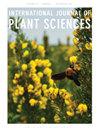美国落基山脉始新世紫藤科植物叶、果化石及其生物地理意义
IF 1.5
3区 生物学
Q3 PLANT SCIENCES
引用次数: 1
摘要
研究的前提。科罗拉多州、犹他州和怀俄明州始新世的沉积物中含有叶子和果序的化石,似乎代表了四蕨科(葫芦属)。今天,这个科由两属(四科和八科)组成,原产于印度、东南亚和澳大利亚的高耸的热带雨林树木。方法。我们研究了现存的四蕨科植物的果实、种子和叶片形态,作为识别化石代表的基础。研究人员在犹他州和科罗拉多州的绿河地层的降落伞溪成员以及怀俄明州西部的布里奇和艾克罗斯地层中研究了化石。通过光学显微镜和微计算机断层扫描(micro-CT)研究了现存和灭绝的物质。关键的结果。鳞翅目小花(Parvaspicula lepidioidea, Cockerell)梳状花序。11 .在其螺旋排列,蒴果,有棱,下子房和顶着床的穗状排列上符合四门科。每个果实通常有四个花柱,花柱之间顶端开裂,使人联想到现存的四柱花序,但是它们共享一个顶盘和现存八柱花序的球茎柱头。毛刺叶(棕色)梳状。11 .在其长叶柄,基部边缘和边缘内的脉,和规则间隔的圆形层状腺体上符合四合藤科。这些腺体很小,覆盖在叶面上,或较大,沿着叶面边缘集中成一排。斑叶在其基部形状、裂片数和边缘类型上变化,与在现存的八棱叶中所见的变化相匹配。结论。Parvaspicula和Punctaphyllum的反复共存,以及这两个器官与现存的Tetramelaceae的形态学相似性,使我们推断它们代表同一种已灭绝植物的部分。这些记录是第一批有文献记载的紫藤科叶和果序化石,表明该科曾经生活在北美,表明其生物地理分布比以前认识的要广泛。本文章由计算机程序翻译,如有差异,请以英文原文为准。
Fossil Leaves and Fruits of Tetramelaceae (Curcurbitales) from the Eocene of the Rocky Mountain Region, USA, and Their Biogeographic Significance
Premise of research. Eocene sediments of Colorado, Utah, and Wyoming contain fossil leaves and infructescences that appear to represent Tetramelaceae (Cucurbitales). Today, this family consists of two genera (Tetrameles and Octomeles) of towering rain forest trees native to India, Southeast Asia, and Australia. Methodology. We examined the fruit, seed, and leaf morphology of extant Tetramelaceae as a basis for recognizing fossil representatives. Fossils were studied from localities in the Parachute Creek Member of the Green River Formation in Utah and Colorado and in the Bridger and Aycross Formations of western Wyoming. Extant and extinct material was studied by light microscopy and micro–computed tomography (micro-CT) scanning. Pivotal results. Infructescences of Parvaspicula lepidioidea (Cockerell) comb. nov. conform to Tetramelaceae in their spicate arrangement of helically arranged, capsular, ribbed fruits with inferior ovaries and parietal placentation. Each fruit typically has four styles and dehisces apically between the styles, reminiscent of extant Tetrameles, but they share an apical disk and the bulbous stigmas of extant Octomeles. Leaves of Punctaphyllum glandulosum (Brown) comb. nov. conform to Tetramelaceae in their long petioles, basal marginal and intramarginal veins, and regularly spaced circular laminar glands. These glands are small and cover the laminae or are larger and concentrated in a single file row along the lamina margin. Punctaphyllum glandulosum varies in its base shape, lobe number, and margin type, matching the variation seen in extant Octomeles leaves. Conclusions. The repeated co-occurrence of Parvaspicula and Punctaphyllum and the morphological similarities of both of these organs with extant Tetramelaceae lead us to infer that they represent parts of the same extinct plant. These records serve as the first documented leaf and infructescence fossils of Tetramelaceae and suggest that the family once lived in North America, indicating broader biogeographic distribution than previously recognized.
求助全文
通过发布文献求助,成功后即可免费获取论文全文。
去求助
来源期刊
CiteScore
4.50
自引率
4.30%
发文量
65
审稿时长
6-12 weeks
期刊介绍:
The International Journal of Plant Sciences has a distinguished history of publishing research in the plant sciences since 1875. IJPS presents high quality, original, peer-reviewed research from laboratories around the world in all areas of the plant sciences. Topics covered range from genetics and genomics, developmental and cell biology, biochemistry and physiology, to morphology and anatomy, systematics, evolution, paleobotany, plant-microbe interactions, and ecology. IJPS does NOT publish papers on agriculture or crop improvement. In addition to full-length research papers, IJPS publishes review articles, including the open access Coulter Reviews, rapid communications, and perspectives. IJPS welcomes contributions that present evaluations and new perspectives on areas of current interest in plant biology. IJPS publishes nine issues per year and regularly features special issues on topics of particular interest, including new and exciting research originally presented at major botanical conferences.

 求助内容:
求助内容: 应助结果提醒方式:
应助结果提醒方式:


